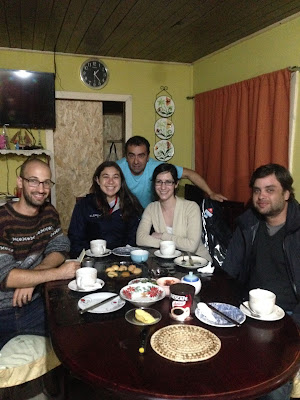This post is part of series all about Chiloe - Chile's second largest island! It's located in Chile's southern Lakes Region and known for seafood and a unique, spooky mythology.
Muelle de las Almas
In 2005, Chilean artist Marcelo Andrés Orellana Rivera created an installation on Chiloe's west coast called the "Dock of Souls." According to local indigenous myths, the souls of the dead are carried to the afterlife on a ghost ship. The Dock of Souls is situated on the site where souls board the ship. A sign at the site explained that, prior to the 1960 earthquake, caves in the cliff face caused sea foam to spew up into the air, at times forming a ship-like shape. We cannot confirm or deny, since the earthquake destroyed those caves. To reach the Dock of Souls from Castro, we first drove across the width of the island, then along the coast on a narrow dirt road. We parked up in the hills, set back a few kilometers from the coast, and went the rest of the way on foot- the hike takes about an hour each way and winds through serene rolling hills filled with grazing sheep.





The Dock itself is just a wooden pier that slopes upwards. The hill drops away below it, making it appear to lead out into the sky, or towards the horizon. A small line of people waited to walk out on it and take a picture. We overheard someone say that during the height of tourist season (January) the line can wrap all the way back up the hill- at least 100 people! Luckily for us the line was only 10 people and nobody was in a rush.
 |
| Kayla enjoys a solo moment on the Muelle de Las Almas |
Muelle de la Luz
 |
| Note that this Muelle spirals under itself! |
From the Dock of Light we could see where a wide river crashed into the ocean, forming a kind of optical illusion where water seemed to flow in from both sides without flowing out (probably forming some kind of dangerous underwater rip current).
The river meets Ocean at this scenic junction. However, the video doesn't capture it too well.
Afterwards, we went farther upriver, where during the 1960 earthquake an entire forest sank 2 meters and was flooded. Dead treetops stick out all along the center of the river.
 |
| We rode past the Flooded Forest for a good 15 minutes upriver by boat. |
 |
| On a future trip, we'd consider kayaking through the smaller Flooded Forest channels. Our guide commented that, despite kayaking's popularity in the area, it's not great because of all the sticks! Hehe |
It's not a competition, but we liked Muelle de la Luz more, despite Muelle de las Almas' fame.































